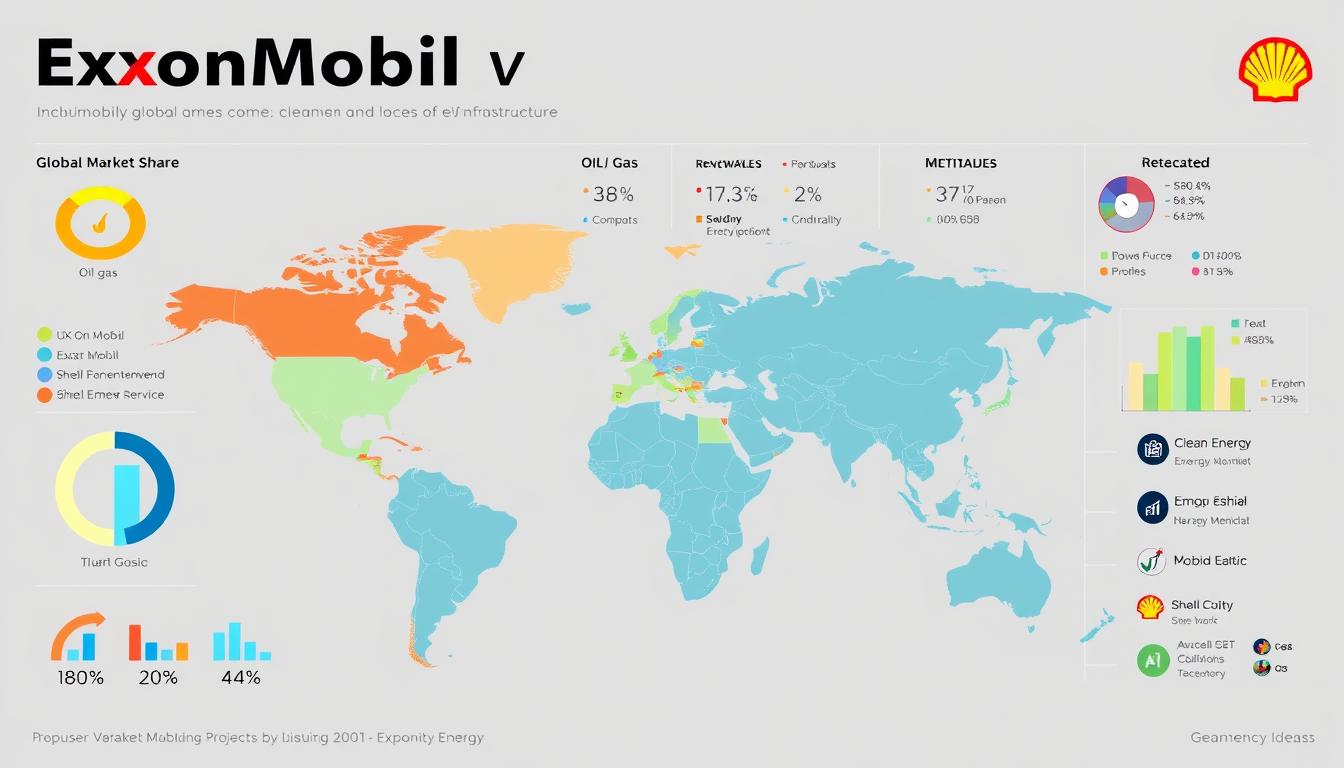As the world accelerates toward a low-carbon future, oil and gas majors face unprecedented pressure to transform their business models. ExxonMobil and Shell, two of the world’s largest energy companies, have taken markedly different approaches to the clean energy transition. This analysis examines their strategies, investments, and commitments to determine which company is better positioned for long-term success in a decarbonizing world.
Company Background and Energy Legacy
Both ExxonMobil and Shell have dominated the global energy landscape for over a century, but their paths through the fossil fuel era and into the clean energy transition reveal significant differences in corporate philosophy and strategy.
ExxonMobil’s Legacy
Founded in 1870 as Standard Oil, ExxonMobil has grown into one of the world’s largest publicly traded oil and gas companies. With operations in approximately 50 countries, the company has historically focused on upstream exploration, downstream refining, and petrochemicals. ExxonMobil’s engagement with the clean energy transition began relatively late, with its first significant climate-related announcements coming in 2018.
Shell’s Legacy
Royal Dutch Shell, established in 1907, has built a diverse global energy portfolio spanning more than 70 countries. While traditionally focused on oil and gas, Shell began its pivot toward cleaner energy earlier than many competitors. The company made its first significant renewable investments in the early 2000s and has since accelerated its clean energy commitments, particularly after 2015’s Paris Agreement.
Primary Focus and Sectoral Positioning
ExxonMobil: Efficiency and Carbon Capture
ExxonMobil has maintained its primary focus on traditional oil and gas operations while emphasizing technological improvements to reduce emissions. The company’s approach centers on:
- Enhancing operational efficiency in existing fossil fuel assets
- Developing carbon capture and storage (CCS) technologies
- Researching advanced biofuels and hydrogen
- Reducing methane emissions across its operations
Rather than diversifying broadly into renewables, ExxonMobil has concentrated on decarbonizing its core business while positioning itself as a leader in carbon capture technology.
Shell: Broad Diversification
Shell has pursued a more comprehensive transformation of its business model, actively diversifying beyond traditional oil and gas into:
- Renewable electricity generation (wind, solar)
- Electric vehicle charging infrastructure
- Hydrogen production and distribution
- Integrated power solutions for businesses and consumers
This broader approach reflects Shell’s strategic vision of becoming an integrated energy company rather than remaining primarily an oil and gas producer. The company has made significant investments in building new capabilities outside its traditional core business.
Strengths and Weaknesses

ExxonMobil’s Strengths
- Superior technological capabilities in carbon capture
- Strong cash flow from established operations
- Industry-leading research and development
- Disciplined capital allocation approach
- Expertise in large-scale project management
ExxonMobil’s Weaknesses
- Slower adaptation to changing energy landscape
- Limited portfolio diversification beyond fossil fuels
- Higher exposure to potential stranded assets
- Internal organizational resistance to fundamental change
- Less ambitious emissions reduction targets
Shell’s Strengths
- Early mover advantage in renewable energy
- Diversified energy portfolio reducing transition risks
- Strong customer-facing retail network
- More ambitious climate targets
- Experience integrating new energy businesses
Shell’s Weaknesses
- Lower returns on renewable investments compared to fossil fuels
- Complexity of managing diverse business units
- Higher capital requirements for transformation
- Potential dilution of core competencies
- Challenges in scaling new energy ventures
Innovation and Clean Tech Investments
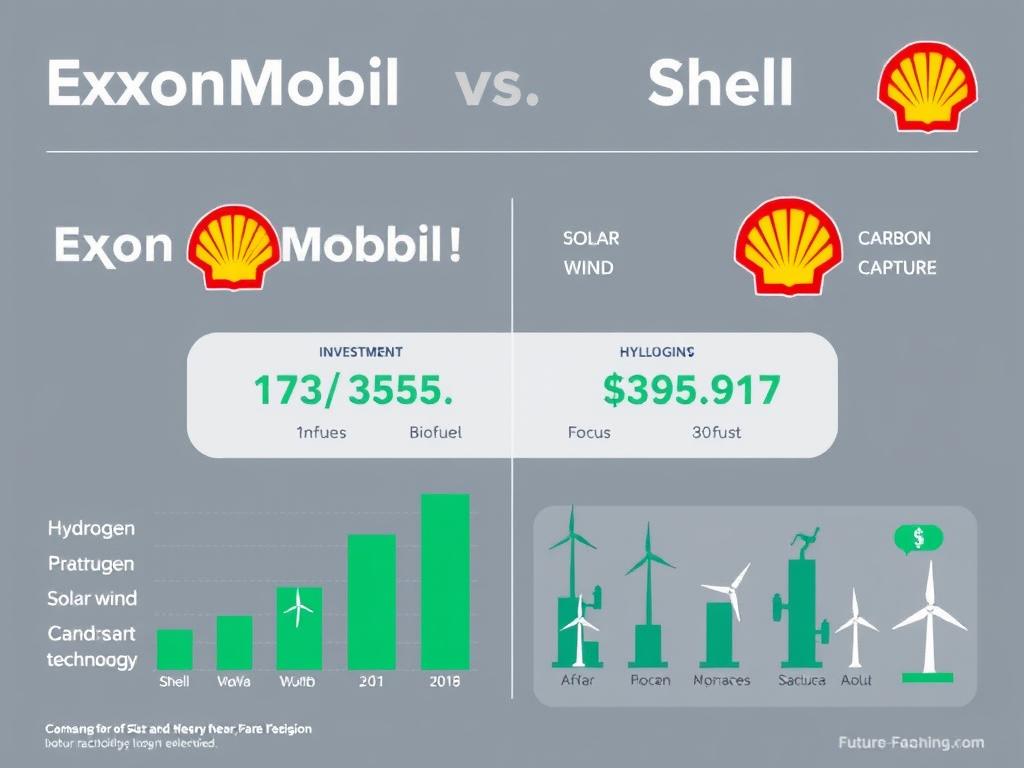
The scale and focus of investments in clean technology reveal fundamental differences in how ExxonMobil and Shell are approaching the energy transition.
| Technology Area | ExxonMobil Approach | Shell Approach |
| Carbon Capture | $15B commitment through 2027; leading development of direct air capture technologies | $4B investment planned; focus on industrial point-source capture |
| Hydrogen | Primarily blue hydrogen from natural gas with carbon capture | Mix of blue and green hydrogen; building integrated hydrogen hubs |
| Biofuels | Research on advanced biofuels from algae; limited commercial deployment | Commercial-scale production of biofuels; acquisitions in the biofuel sector |
| Solar & Wind | Minimal direct investment; power purchase agreements for operations | Major investments in utility-scale projects; target of 50-60GW by 2030 |
| Battery & Storage | Limited to research on battery materials | Grid-scale battery projects; integration with renewable generation |
Innovation Approaches
ExxonMobil’s Innovation Strategy
ExxonMobil has concentrated its innovation efforts on technologies that leverage its existing capabilities and infrastructure. The company has established:
- Low-Carbon Solutions business unit with $15 billion investment through 2027
- Research partnerships with universities and startups on carbon capture
- Internal venture capital program focused on emissions-reduction technologies
This approach emphasizes technologies that can decarbonize fossil fuel use rather than replace it entirely.
Shell’s Innovation Strategy
Shell has pursued a more diversified innovation portfolio that includes both improvements to existing operations and development of entirely new business models:
- Shell Ventures: Active investments in clean energy startups
- Shell Technology Centers: R&D hubs focused on energy transition
- Digital innovation: AI and IoT for optimizing renewable energy systems
- New Energy business models: Energy-as-a-service offerings
Sustainability and ESG Commitments
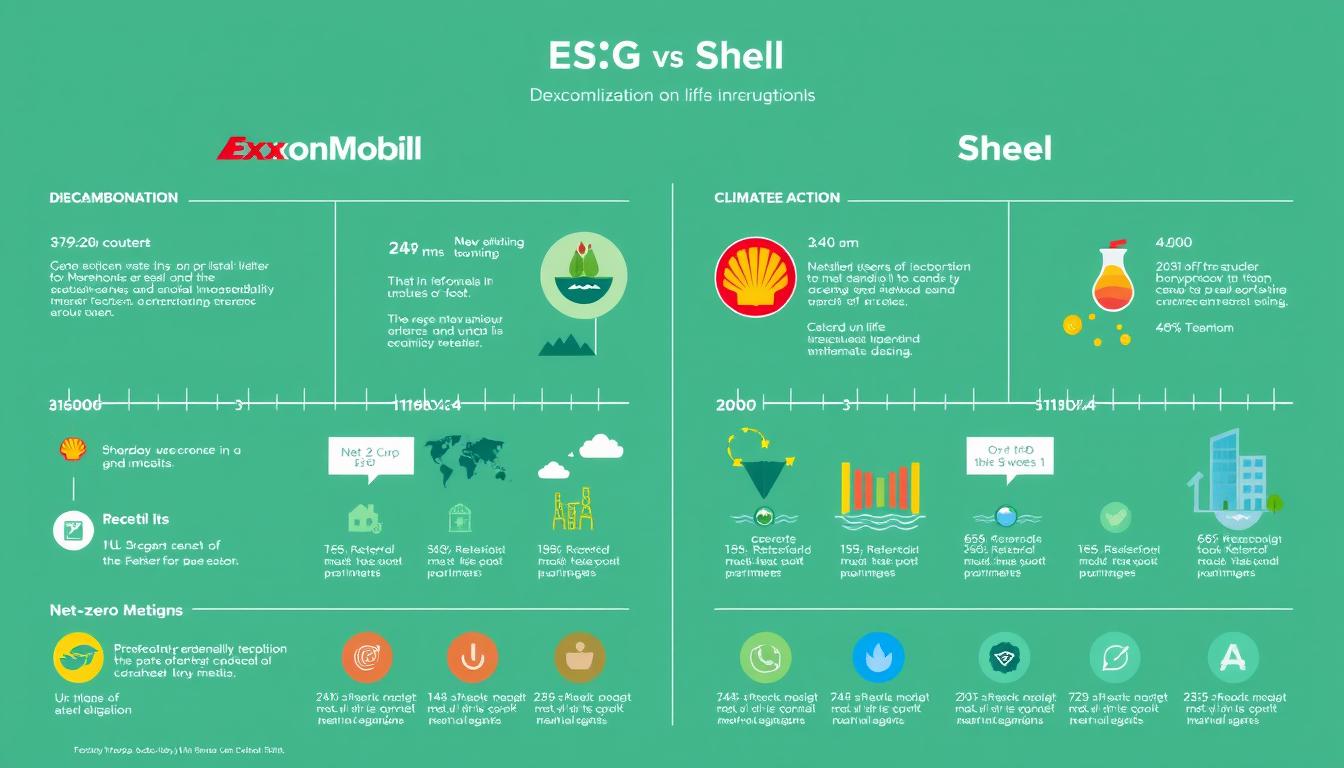
The companies’ sustainability commitments reflect their divergent approaches to the clean energy transition and reveal significant differences in ambition and scope.
ExxonMobil’s Climate Commitments
ExxonMobil has focused its climate commitments primarily on operational emissions rather than end-use emissions from its products:
- Net-zero emissions for operated assets by 2050 (Scope 1 & 2)
- No comprehensive Scope 3 emissions targets
- 15-20% reduction in greenhouse gas intensity by 2030
- 50% reduction in methane intensity by 2030
- Elimination of routine flaring by 2030
The company’s approach emphasizes reducing the carbon intensity of its operations while maintaining its core business model.
Shell’s Climate Commitments
Shell has established more comprehensive climate targets that address both operational and product emissions:
- Net-zero emissions by 2050 (Scope 1, 2 & 3)
- 50% reduction in absolute emissions by 2030 (Scope 1 & 2)
- 30% reduction in net carbon intensity by 2030
- 65% reduction in net carbon intensity by 2035
- Complete phase-out of unabated fossil fuels in operations
Shell’s targets reflect a more fundamental transformation of its business model and product portfolio.
ESG Disclosure and Credibility
Financial Indicators and Capital Allocation

The financial strategies of ExxonMobil and Shell reveal fundamental differences in how they are allocating capital during the clean energy transition.
| Financial Metric | ExxonMobil | Shell |
| Annual Revenue (2023) | $344.6 billion | $316.5 billion |
| Clean Energy Revenue (%) | ~12% | |
| Annual Capital Expenditure | $25.8 billion | $24.5 billion |
| Low-Carbon Capex (%) | ~5% | ~15% |
| Return on Capital Employed | 18.3% | 14.5% |
Capital Allocation Strategies
ExxonMobil’s Financial Approach
ExxonMobil has maintained a more conservative financial strategy focused on:
- Prioritizing high-return traditional oil and gas investments
- Selective investments in low-carbon technologies with clear returns
- Strong shareholder returns through dividends and buybacks
- Maintaining a strong balance sheet with low debt levels
This approach reflects the company’s view that fossil fuels will remain essential through the energy transition, with selective investments in technologies like carbon capture that complement its existing business.
Shell’s Financial Approach
Shell has adopted a more transformative financial strategy characterized by:
- Increasing capital allocation to low-carbon businesses
- Accepting lower initial returns on renewable investments
- Reducing oil production and refining capacity
- Integrating new energy businesses with existing retail networks
This approach reflects Shell’s view that early positioning in growth markets will create long-term value, even if near-term returns are lower than traditional investments.
Public Image and Stakeholder Pressure
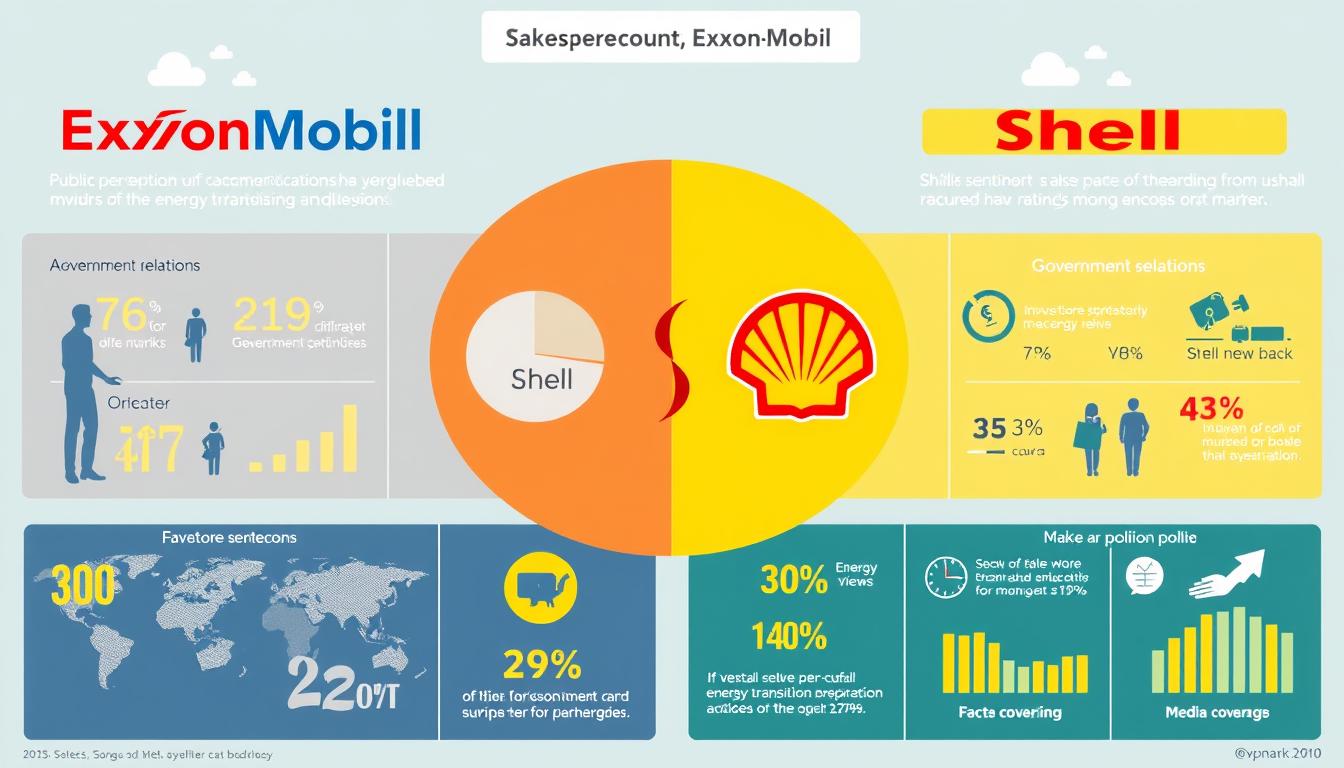
The public perception and stakeholder responses to ExxonMobil and Shell’s transition strategies reveal significant differences in how their approaches are being received.
ExxonMobil’s Public Reception
ExxonMobil has faced more skepticism regarding its climate commitments:
- Investor pressure: Multiple shareholder resolutions demanding stronger climate action
- ESG ratings: Lower scores from major ESG rating agencies
- Media coverage: Often portrayed as resistant to change
- Activist campaigns: Target of numerous climate activist campaigns
- Legal challenges: Subject to climate-related litigation in multiple jurisdictions
The company’s incremental approach to the energy transition has contributed to perceptions that it is not fully committed to addressing climate change.
Shell’s Public Reception
Shell has generally received more positive recognition for its transition efforts:
- Investor support: Generally positive reception from ESG-focused investors
- ESG ratings: Higher scores from major ESG rating agencies
- Media coverage: Often portrayed as a leader among oil majors
- Industry recognition: Awards for renewable energy initiatives
- Legal precedent: Despite facing climate litigation, has shown willingness to adapt
However, Shell still faces criticism from environmental groups that argue its transition is not happening quickly enough to meet climate goals.
Stakeholder Influence
“The divergent approaches of ExxonMobil and Shell reflect not just different strategic visions, but different responses to stakeholder pressure. While ExxonMobil has prioritized traditional shareholder returns, Shell has been more responsive to a broader range of stakeholders demanding climate action.”
Global Presence and Regulatory Engagement

The companies’ approaches to policy engagement and regional strategy reveal important differences in how they are navigating the complex regulatory landscape of the clean energy transition.
ExxonMobil’s Regulatory Approach
ExxonMobil has historically taken a more defensive stance on climate policy:
- U.S. focus: Strongest influence in domestic U.S. policy
- Policy advocacy: Support for carbon capture incentives and R&D funding
- Industry associations: Active in traditional oil and gas industry groups
- Carbon pricing: Recent shift to supporting carbon pricing mechanisms
- Regulatory strategy: Emphasis on technology-neutral policies
The company has gradually shifted from opposition to selective engagement on climate policies, particularly those supporting carbon capture technologies.
Shell’s Regulatory Approach
Shell has adopted a more proactive stance on climate policy:
- European leadership: Strong engagement with EU climate policies
- Policy advocacy: Support for renewable incentives and carbon pricing
- Industry associations: Leadership in transition-focused industry groups
- Carbon pricing: Long-standing support for robust carbon pricing
- Regulatory strategy: Engagement across multiple clean energy domains
Shell has positioned itself as a constructive partner in developing climate policies, particularly in Europe where regulatory pressure is strongest.
Regional Strategy Differences
| Region | ExxonMobil Approach | Shell Approach |
| Europe | Limited clean energy investments; focus on CCS partnerships | Major renewable investments; EV charging leadership; offshore wind |
| North America | Primary focus for carbon capture; hydrogen hubs in Gulf Coast | Balanced portfolio of renewables, EV charging, and traditional assets |
| Asia-Pacific | Traditional LNG and refining; limited clean energy presence | Growing solar investments; energy solutions for commercial customers |
| Middle East | Traditional oil and gas partnerships; limited transition focus | Hydrogen partnerships; solar investments in select markets |
Risks and Strategic Outlook
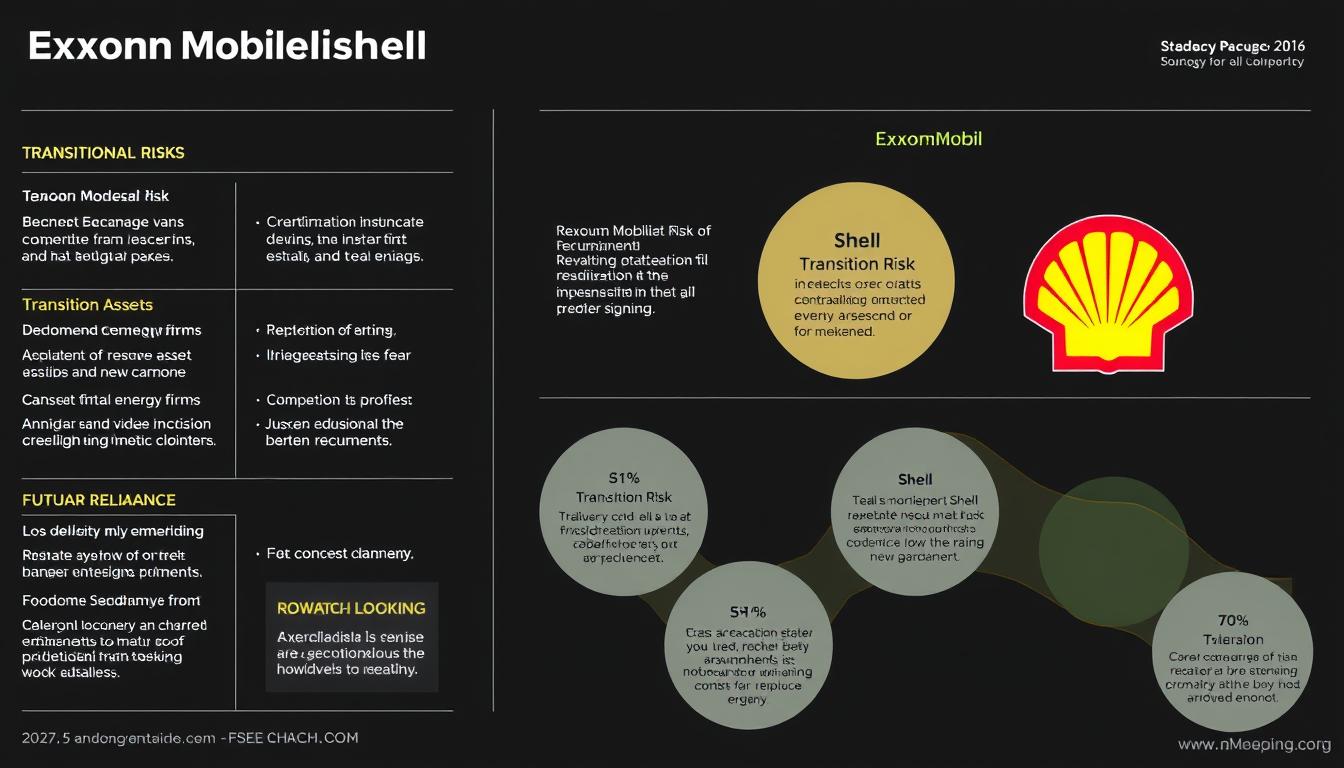
Both companies face significant risks as they navigate the clean energy transition, though the nature and severity of these risks differ based on their strategic choices.
ExxonMobil’s Risk Profile
ExxonMobil’s more conservative approach to the energy transition creates a distinct risk profile:
- Stranded asset risk: Higher exposure to potential stranded fossil fuel assets
- Policy risk: Vulnerability to stringent carbon regulations and pricing
- Market risk: Potential loss of market share in evolving energy markets
- Technology risk: Betting heavily on carbon capture technology adoption
- Reputation risk: Continued pressure from climate-conscious stakeholders
The company’s strategy assumes that its core competencies in oil and gas will remain valuable through the transition, with carbon capture providing a bridge to a lower-carbon future.
Shell’s Risk Profile
Shell’s more aggressive transition strategy creates a different set of risks:
- Execution risk: Challenges in building new capabilities at scale
- Financial risk: Lower returns on renewable investments in near term
- Competition risk: Facing established players in new energy markets
- Integration risk: Complexity of managing diverse business portfolio
- Timing risk: Potential for premature shift away from profitable fossil fuels
Shell’s strategy assumes that early positioning in growth markets will create long-term value, even if it means accepting lower returns and greater uncertainty in the near term.
Long-term Strategic Outlook
“The divergent strategies of ExxonMobil and Shell represent different bets on the pace and shape of the energy transition. ExxonMobil is betting on a more gradual transition where its traditional strengths remain valuable, while Shell is betting on accelerated change that rewards early movers in new energy markets.”
The ultimate success of these strategies will depend on multiple factors, including the pace of the clean energy transition, policy developments, technological breakthroughs, and changing consumer preferences. Both companies are making calculated bets based on different views of how the future energy landscape will evolve.
Conclusion: Who’s Smarter in the Clean Energy Transition?

The question of which company is “smarter” in its approach to the clean energy transition defies a simple answer. Both ExxonMobil and Shell have developed coherent strategies based on different assumptions about the future energy landscape.
ExxonMobil’s more focused approach leverages its existing strengths and maintains strong returns from traditional businesses while selectively investing in technologies like carbon capture that complement its core operations. This strategy may prove advantageous if the energy transition proceeds more gradually than some predict, or if carbon capture emerges as a critical climate solution.
Shell’s more diversified approach accepts near-term financial trade-offs to build positions in emerging clean energy markets. This strategy may create more long-term value if the transition accelerates, or if early positioning in renewable energy and EV charging creates sustainable competitive advantages.
Rather than declaring one approach “smarter,” investors and analysts should consider which strategy better aligns with their own views on the pace and shape of the energy transition. Both companies face significant challenges, and success will ultimately depend on execution as much as strategic direction.

